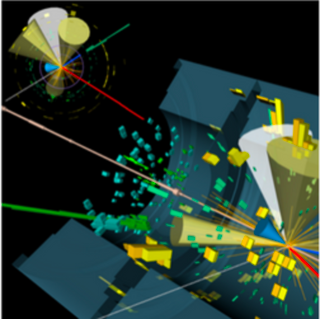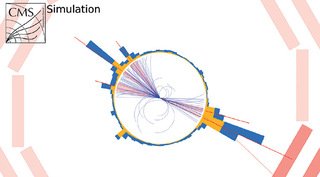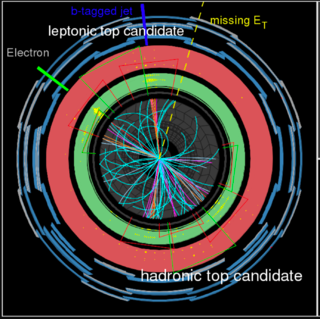The importance of top partners for particle physics (and the Higgs boson)
The Higgs boson was the last missing link of the Standard Model of particle physics and has been discovered already 5 years ago (on July 4th 2012, to be precise).

[image credits: ATLAS@CERN]
The Higgs boson solves many issues of the Standard Model of particle physics. For instance, it provides a (more or less) simple explanation for the particle masses and is also one of the cornerstones relating the weak and electromagnetic interactions to each other.
The famous boson however also brings its set of conceptual problems and limitations.
For this reason, physicists are trying today (and actually for more than a couple of decades) to find particles known as top partners, in particular at the Large Hadron Collider (the LHC), at CERN.
This important research topic (that will be more deeply defined below) is what I will talk about in this article. Yep, partnership is also important in particle physics. :p
THE FUNDAMENTAL INTERACTIONS AND THEIR STRENGTH
The hierarchy problem of the Standard Model is one of the main motivation for the existence of the top partners. I am thus left with two things to define: what is a top partner and what is the hierarchy problem.

[image credits: CMS@CERN]
I will start with the latter and the former is illustrated on the picture on the right.
This simulated CMS (one of the experiments at the LHC) event could result from the production of a pair of top partners, followed by their subsequent decay. The decay products are what is observed in the CMS detector.
This being said, let us go back to the hierarchy problem of the Standard Model. It is exactly what it means: there is a hierarchy somewhere in the theory and this hierarchy brings its set of complication. This is connected to the fundamental interactions of the theory.
There are four fundamental interactions in nature: gravity, electromagnetism, the weak interactions and the strong interactions. Each of these interactions has a given strength, and this strength shows how strongly each interaction is.
The strong interaction is the most intense one and this is how the name comes from. Not a surprize, isn’t it?
Electromagnetism comes next (and is 100 times weaker), then the weak interaction that is 10.000 times weak than the strong interaction. Finally comes gravity, which is 1.000.000.000.000.000.000.000.000.000.000.000.000 weaker than the strong interaction.
A hierarchy is now apparent! ;)
THE HIERARCHY PROBLEM IN MORE DETAILS
The hierarchy problem is in fact connected to the huge difference in the interaction strengths depicted above.
In the Standard Model, weak interactions and electromagnetism are unified in a way involving the so-called electroweak interactions. The strength of the latter is similar to the weak interaction strength.
In particle physics, we are dealing with energy scales rather than strengths (both are connected very easily). And the hierarchy problem is nothing but the fact that the electroweak scale (connected to the weak interactions) and the Planck scale (connected to gravity) are separated by many orders of magnitude.

[image credits: the particle zoo]
But is this really a problem?
More or less: the Higgs boson is making it a problem. And as we know today that the Higgs boson (I use the Higgs plush representation on the left, for the fun) exists…
The electroweak scale is additionally connected to the elementary particle masses, and for a very good reason.
The Higgs boson is what connects the electroweak interactions to the weak interactions and electromagnetism. And the Higgs boson is also the guy responsible for all particle masses.
All of this is achieved via a single quantity that is known as the vacuum expectation value of the Higgs field.
This is a complicated term that I will not really define, but one can just keep in mind that there is a single key quantity connected to the Higgs boson that drives all particle masses as well as the way in which electroweak interactions are connected to the weak interactions and electromagnetism.
WHEN THE QUANTUM WORLD STRIKES BACK
The hierarchy problem comes as the elementary particles are living in a quantum world.
The Higgs vacuum expectation value (the key quantity explaining everything) is a prediction of the theory from which all masses are derived once a few free parameters are fixed. We moreover know all particle masses from experiment.
As there are more masses than free parameters, we can make predictions and test the theory. Standard Model predictions should nonetheless include the associated quantum corrections, and the latter are super-sensitive to the scale hierarchy above-mentioned, as a result of the Higgs boson nature.
If we setup the model parameters roughly (in order to get an agreement relatively to particle mass data) and compute the quantum corrections, the prediction for the Higgs vacuum expectation value is the Planck scale, whatever we do, instead of the electroweak scale.
As a result, we should tune the parameters of the Standard Model up to their 30th decimal. By doing so, we will get the right results. But if one changes the 30th digit of one parameter, the predictions are sent far far away, and this is a problem.
THE INFLUENCE OF THE TOP QUARK
As a result of the above issue, physicists believe that new physics clarifies the situation and stabilizes the Higgs with respect to quantum corrections. Different mechanisms have been designed in order to soften the dependence on this hierarchy of scales.
It is good to recall here that the Standard Model of particle physics contains six quark species, three up-type quarks and three down-type quarks. They have similar properties, except their masses. The heaviest of all quarks is the top quark, a very heavy copy of the up quark that makes protons and neutrons (together with down quarks).

[image credits: ATLAS@CERN]
The top quark has been discovered more than 20 years ago, and the LHC has already produced millions of them.
This is illustrated with the picture on the right, that contains a real collision recorded by the ATLAS detector in which two top quarks have been produced.
One of the key players that sends the Higgs vacuum expectation value to the Planck scale is in fact this top quark, as it is the heaviest known elementary particle and thus the guy with the strongest connection to the Higgs boson.
AND NOW THE PARTNERS
In many new physics theories (based, for instance, on symmetries like in the Standard Model), extra particles are predicted near the electroweak scale and have the role to cancel the top quark effects on the Higgs vacuum expectation value.
These particles having a specific role with respect to the top quark, they are generically named partners of the top quark. No fancy word this time :)
This is why we are talking about top partners, and why their search is crucial. We need to understand how the Higgs is stabilized, and thus discover the remnants (the partners) of the underlying mechanism.
One last question is the following: why is this timely?
Once the partners cancel the dependence of the theory predictions on the scale hierarchies, it introduces a dependence on the partner masses. In order not to get a new hierarchy problem, the partner masses should be of the order of the electroweak scale, and is thus in principle reachable with the LHC.
And this is why the partners are heavily searched for at the LHC at CERN.
TAKE-HOME MESSAGE
Anything connected to the Higgs boson suffers a lot from the difference between the strength of gravity and the one of the weak interactions.
This is in particular driven by the top quark (the heaviest known elementary particle), and one way to cure the issue is to postulate the existence of top partners that will compensate all effects induced by the hierarchy of scales.
Those partners are predicted to be within the reach of the LHC, at CERN, and their search is thus a crucial ingredient of the experimental program in particle physics. However, no observation so far so that physicists are already on their way for designing new mechanisms explaining both the hierarchy and the LHC null results.
I have no specific references to share for this post as everything comes from my mind and years of experience in the field. I can only recommend specialized books that may not be very helpful for the audience. As a result, I have checked the wikipedia page, and it is fine. This page is also very good (reference number 1 on wikipedia).
For more discussion on this topic (or anything related to science), please join us on #steemSTEM.
Great article as always. Why do you think gravity is so weak?
Thanks a lot!
That is a good question. And I don't know the answer. There are theories (like extra-dimensional theories) where the weakness of gravity is a consequence of the existence of the extra dimensions where gravity propagates.
It would be cool if we could see these extra dimensions with optic tools, but I don't think it will be ever possible. Also, I have heard that there is another way to proof extra dimensions - if heavier versions of particles from Standard Model existed that would be a proof that there are more dimensions than 4. I made a post about the history of trying to unify all interactions and during research I found an interesting article about it but I can't find it now.
One way to find them would indeed be first to observe excitations of the Standard Model particles at colliders, and next to show that they satisfy the expected properties from extra dimensional models.
Physics always was the weak subject of mine from school time !
I dont know why :/
PHYSICS is the science where you use extremely long and complicated formulas to explain why a ball rolls.
There are ways to explain things without any formula. However, as soon as you want to predict anything, there is no way out ;)
Another well documented article by @lemouth. Thanks for taking the time to not only thoroughly explain advanced physics to us but also make easy to understand since we are not all professionals.
You are welcome! It is my pleasure!
Interesting discussion @lemouth. Would like to hear more of your concepts and ideas. Keep sharing
Which one exactly? I would be please to write about it. Note that I may have written on it in the past ;)
@lemouth
Wonderful material 👍👍
Continue 👈
☺☺☺☺👍👍👍👍
amazing post
thank you
followed and upvoted !!
#All things depends on maths and physics..(^_^).....
#Upvoted and #Resteemed
I am so happy to finally find a social network that supports me and helps me to support others - it's a great feeling of balance.As you can see from my post summary for the last week (below), I haven't been hanging around- I've made lots of posts on important subjects, in fact this week the subjects are some of the most important on Earth thatmany still don't understand.. Plus, I created 2 new add-ons for Steemit - A full visual Rethemeand a way of making downvotes more visible.
Congratulations @lemouth! You have completed some achievement on Steemit and have been rewarded with new badge(s) :
Click on any badge to view your own Board of Honor on SteemitBoard.
For more information about SteemitBoard, click here
If you no longer want to receive notifications, reply to this comment with the word
STOP